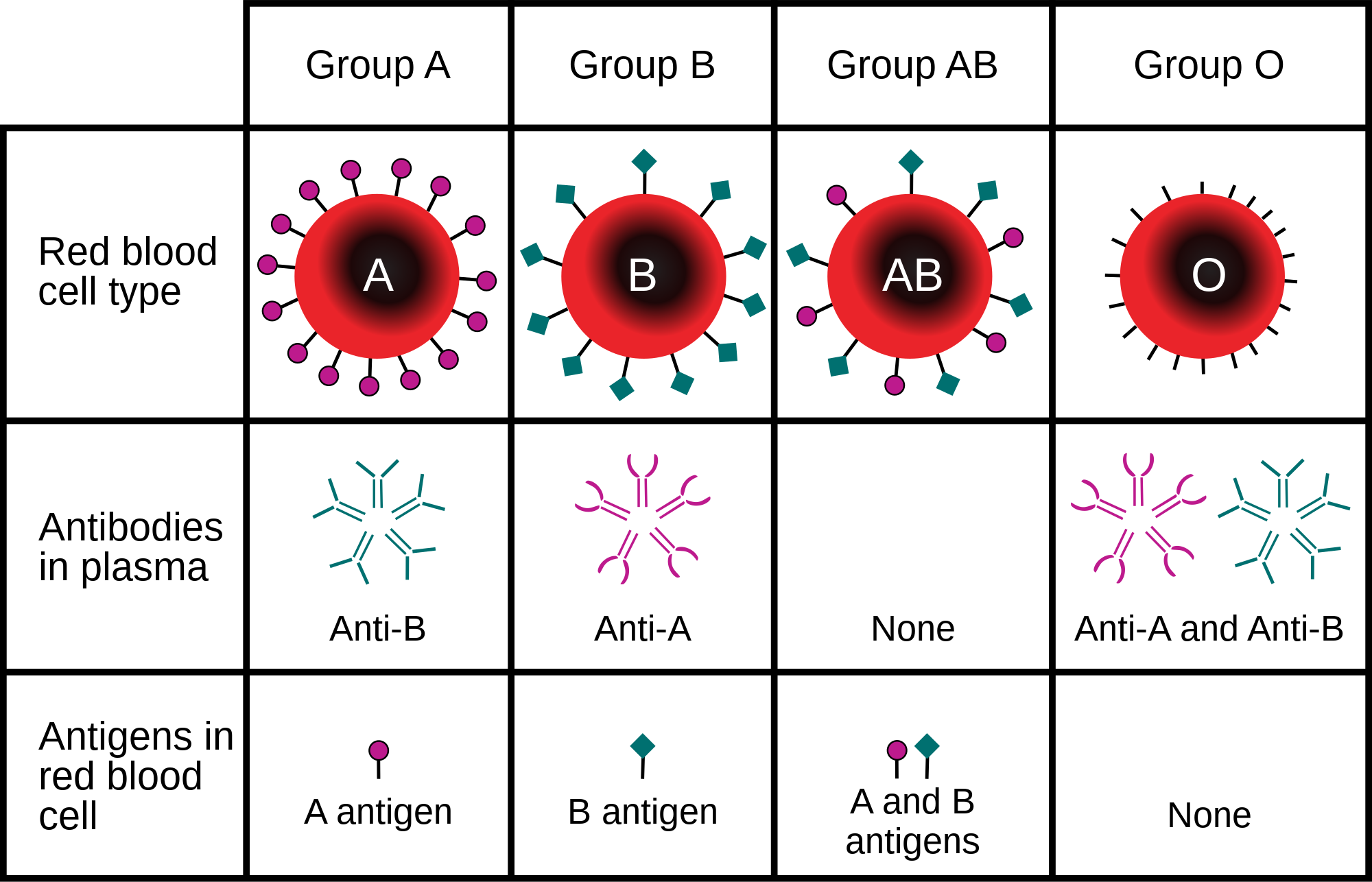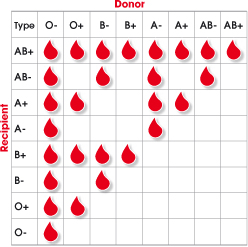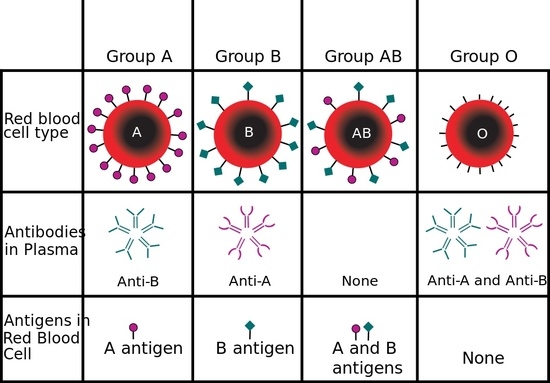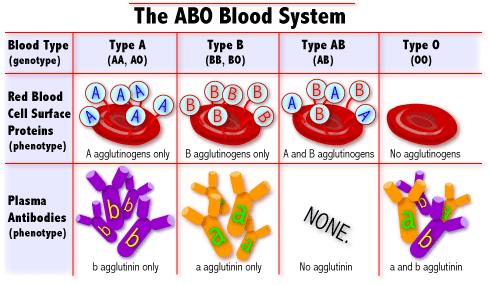Blood type
A blood type is a description of the individual composition of the glycolipids or proteins (proteins ) on the surface of red blood cells of higher organisms, especially humans. The surfaces differ in various glycolipids, or proteins, which act as antigens.
The immune system produces antibodies against foreign antigens. If the blood of different blood groups are mixed, the result is clumping ( agglutination) of red blood cells due to binding by antibodies. Before the discovery of blood groups therefore blood transfusions were successful only by accident and often ended fatally.
In humans, there are a variety of different blood group systems, 29 of which are at the ISBT ( International Society of Blood Transfusion ) recognized and described. The most important blood group systems are the AB0 system and the Rhesus system, which are based in each case on a particular antigen. These two are due to their strong agglutination of particular importance. Blood groups are inherited and are therefore a feature to exclude relationships can, for example, by parentage.
Blood group systems
Definition
A blood group system may consist of one or more antigens, which are on the membrane of the red blood cells and to other individuals of the same species, which antibodies can be formed (so called allo- antibodies). The assignment of antigens to a blood group system is via the coding genes for them. Each blood group system must be separated genetically from other by definition. This is possible in two ways:
- The antigens of blood group system are encoded by a single gene. They are therefore different forms of a single gene ( alleles).
- The antigens of the blood group system encoded by several closely related homologous genes between which virtually there is no recombination.
Blood group systems according to ISBT
AB0 system
The AB0 system was described in 1901 by the Viennese physician Karl Landsteiner, for which he won the Nobel Prize for Medicine was awarded in 1930. The Hygiene Commission of the League of Nations decided in 1928 to designate the blood groups uniformly throughout the world. They opted for the AB0 system. The AB0 blood group system is the most important feature in the blood transfusion and comprises four main groups: A, B, AB and 0
The antibodies against factors in the AB0 system are trained in humans during the first year of life. The combination of A and B acts co-dominant, recessive, the factor 0. The blood group AB0 system raised by their great importance, together with the Rhesus factor D for decades regularly worldwide.
Rhesus system
The antibodies against the Rhesus D are formed only in people without this factor when they come into contact with him. This can be done in blood transfusions, in women during pregnancy, especially at birth.
The problem of the Rhesus factor can be when a Rhesus -negative woman gets a Rhesus - positive child. If antibodies are present, such as the birth of the first child, it can during pregnancy to an increased degradation of the loaded with antigens red blood cells ( erythrocytes) in the second Rhesus positive child and thus to a life-threatening complication, the hemolytic disease of the newborn to come. Can be counteracted this episode through blood exchange. Today, however, this is usually unnecessary because already at first pregnancy, an anti - D prophylaxis is carried out, which suppresses the formation of antibodies.
The name Rhesus comes from the experiments with rhesus monkeys, which had been discovered in 1937, this factor first. Here, Karl Landsteiner had found antibodies to A and B continue to be written as C, D and E. Medical is particularly relevant among these the rhesus factor D.
The Rh factor is inherited dominantly, so the blood group is Rhesus negative feature rare.
Kell system
The Kell system is the third most important system in blood transfusions. For blood donors in Germany and Austria is regularly tested for Kell antibodies.
92 % of people are Kell negative ( kk) and should only receive Kell - negative blood. 7.8% are heterozygous Kell - positive ( Kk ) and can receive blood with positive and negative Kellfaktor. Only 0.2 % of people are homozygous Kell - positive ( KK) and need Kell - positive blood. 99.8 % of all people can be supplied with Kell - negative blood, although hospitals need both Kell - negative and Kell - positive blood. Blood donations with a positive Kell factor (KK or Kk ) can not be used only in a few exceptional cases ( such as pregnancy).
The inheritance is not fully understood. Currently, it is assumed that four antigenic types, which are highly polymorphic, which the MHC genes also in close relationship leads to similar strong variation ( GeneID 3792 ). The Kell antibodies ( anti -K, K1) together with the genetically Cellano antibody ( anti -K, K2) to the KC combined system, since the proteins are very similar. The names of these antibodies of the IgG type are each named after pregnant patients - antibody of Kell Cellano system can lead to serious incidents in transfusions and pregnancies.
MN system
In the MN system, there are three phenotypes caused by three genotypes, resulting from the combination of two codominant alleles:
The MN system is grouped with the other antigens S, s and U for MNS system.
Duffy system
Duffy factor is an antigen and also a receptor for plasmodium vivax, the causative organism of malaria tertiana. Duffy -negative carriers of the trait are resistant to those transmitted by the Anopheles mosquito pathogen, since the altered receptor contact with the host cell prevents ( GeneID 2532 ).
Other systems
Cellano, Kidd ( Jk ), Lewis, Lutheran (Lu), MNSs, P and Xg are the names of other blood group systems. They stand for more antibodies against blood components which have been usually named after the patients in whom they were first observed. If a patient shows the corresponding antibodies in the blood, it can lead to dangerous, repeatable complications after a blood transfusion. Usually only the antibody is known, which can be detected by a test ( clotting test with the blood), whereas the genetic basis is not known yet.
In the investigation on blood groups today is regularly testing for rare antibodies. Their positive result must be indicated individually in the clinical indication of the blood group. These patients can only autologous blood or blood from other sources are given with the same specificity.
Frequency of blood groups
The frequencies of blood groups vary regionally. In certain areas of Asia blood type B is the most frequent in Europe blood group A. On the basis of the frequencies can be - with limitations - reconstruct migration of population in the past. In the allele frequency is "0" most frequently occurring, as a recessive trait but not everywhere as the most common blood group present. This indicates that a selective advantage.
Evolution of blood groups
On the origin of the different blood groups ( AB0 system ), there is little good evidence. Molecular Biology research indicates that blood type is 0 arose prior to about 5 million years ago due to a genetic mutation of blood group A. It has also been found that the carriers of blood group 0 in the case of malaria infection ( Plasmodium falciparum ) have a higher chance of survival. This selective advantage has therefore helped in the humid tropical zones of Africa and in the Americas the blood group 0 is more common than in other regions of the world. What other factors influenced the emergence and spread of different blood groups, is still largely unclear.
Compatibility between the blood groups, universal donor
→ Main article: Universal donor and universal recipient
A cross in the table means that a transfusion from donor to recipient is possible. This is true in part on the condition that only the blood cells are transferred. For a transfer from whole blood, ie including the blood plasma, the different blood groups of the AB0 system are always incompatible.
As a universal donor blood donor applies in transfusion medicine with blood group 0 -. Erythrocytes of blood group in fact have no A or B antigens. Among others, a degradation of the receiver erythrocytes ( hemolysis) to avoid by antibodies to A and B in the serum of a donor (minor response), are administered today no whole blood, red cell concentrates, but otherwise would be, for example, a a donation to an AB recipient not possible (see above).
As a common feature of all blood groups are N- acetylglucosamine is present in the glycocalyx of the erythrocytes. It binds galactose. At the galactose fucose is not bound. These form the blood group 0 or the " family tree " of all blood types. In addition to the galactose nor N -acetylgalactosamine (blood group A) or another galactose bind (blood group B).










